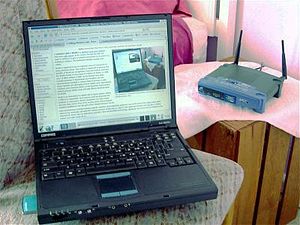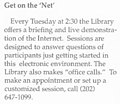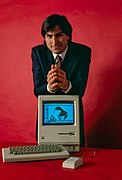The Internet PortalThe Internet (or internet) is the global system of interconnected computer networks that uses the Internet protocol suite (TCP/IP) to communicate between networks and devices. It is a network of networks that consists of private, public, academic, business, and government networks of local to global scope, linked by a broad array of electronic, wireless, and optical networking technologies. The Internet carries a vast range of information resources and services, such as the interlinked hypertext documents and applications of the World Wide Web (WWW), electronic mail, telephony, and file sharing. The origins of the Internet date back to research that enabled the time-sharing of computer resources and the development of packet switching in the 1960s which led to the design of computer networks for data communication. The set of rules (communication protocols) to enable internetworking on the Internet arose from research and development commissioned in the 1970s by the Defense Advanced Research Projects Agency (DARPA) of the United States Department of Defense in collaboration with universities and researchers across the United States and in the United Kingdom and France. The ARPANET initially served as a backbone for the interconnection of regional academic and military networks in the United States to enable resource sharing. The funding of the National Science Foundation Network as a new backbone in the 1980s, as well as private funding for other commercial extensions, encouraged worldwide participation in the development of new networking technologies and the merger of many networks using DARPA's Internet protocol suite. The linking of commercial networks and enterprises by the early 1990s, as well as the advent of the World Wide Web, marked the beginning of the transition to the modern Internet, and generated sustained exponential growth as generations of institutional, personal, and mobile computers were connected to the network. Although the Internet was widely used by academia in the 1980s, the subsequent commercialization in the 1990s and beyond incorporated its services and technologies into virtually every aspect of modern life. (Full article...) Selected articleMegatokyo is an English-language webcomic created by Fred Gallagher and Rodney Caston, debuting on August 14, 2000, and then written and illustrated solely by Gallagher as of July 17, 2002. The style of its writing and illustrations is heavily influenced by Japanese manga. Megatokyo is freely available on its official website, with updates on Monday, Wednesday, and Friday. It is among the most popular webcomics, and is published in print by CMX. Sales of the comic's print editions rank it as the best selling original English-language manga. Set in a fictional version of Tokyo, Megatokyo portrays the adventures of Piro, a young fan of anime and manga, and his friend Largo, a video game enthusiast. The comic often parodies and comments on the archetypes and clichés of anime, manga, dating simulations and video games, occasionally making direct references to real-world works. Megatokyo was originally presented in the gag-a-day format, with continuity of the story a subsidiary concern. Over time, it focused more on developing a complex plot and the personalities of its characters. This transition was due primarily to Gallagher's increasing control over the comic, which led to Caston's controversial removal from the project. Megatokyo has received praise from such sources as The New York Times, while negative criticism of Gallagher's changes to the comic has been given by sources including Websnark. Selected picture A wireless LAN or WLAN is a wireless local area network, which is the linking of two or more computers without using wires. WLAN utilizes spread-spectrum or OFDM modulation technology based on radio waves to enable communication between devices in a limited area, also known as the basic service set. This gives users the mobility to move around within a broad coverage area and still be connected to the network. News
Wikinews Internet portal
WikiProjects
Did you know (auto-generated) -
Selected biographyLeonard Kleinrock (born June 13, 1934 in New York) is a computer scientist, and a professor of computer science at UCLA, who made several important contributions to the field of computer networking, in particular to the theoretical side of computer networking. He also played an important role in the development of the ARPANET at UCLA. His most well-known and significant work is his early work on queueing theory, which has applications in many fields, among them as a key mathematical background to packet switching, the basic technology behind the Internet. His initial contribution to this field was his doctoral thesis in 1962, published in book form in 1964; he later published several of the standard works on the subject. His theoretical work on hierarchical routing, done in the late 1970s with his then-student Farouk Kamoun, is now critical to the operation of today's world-wide Internet. General images -The following are images from various internet-related articles on Wikipedia.
Selected quoteMore Did you know...
Main topics
Featured contentCategoriesRelated portalsThings you can do
Associated WikimediaThe following Wikimedia Foundation sister projects provide more on this subject:
Wikipedia's portals |



















































